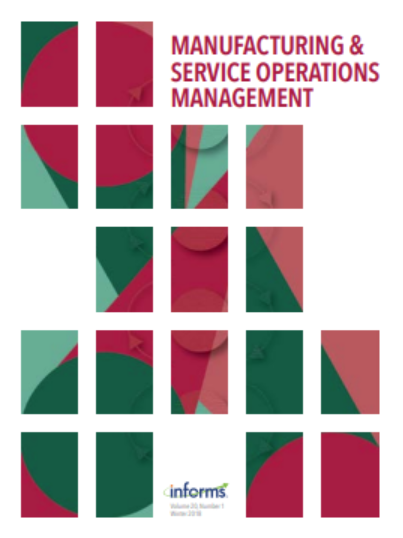团购中的消费者均衡、需求效应与效率
IF 4.8
3区 管理学
Q1 MANAGEMENT
引用次数: 7
摘要
问题定义:我们探索团购事件中的消费者均衡和效率,在团购事件中,商品或服务的单价随着消费者注册数量的增加而降低。具体来说,我们研究了以下问题:(i)在这些事件中,动态消费者注册均衡是如何演变的?(ii)是否有经验证据表明团购增加了需求?如果是的话,增加多少?采用这一机制是否有利润收益?如何加以改进?学术/实践意义:团购活动在某些市场越来越受欢迎,尤其是在中国。我们的研究有助于更好地理解这种创新的定价机制及其对需求和利润的影响,并有助于在实践中更有效地实施。方法:建立连续时间动态博弈理论模型,研究消费者行为并求解其均衡。然后,我们将其应用于大型零售商团购事件中获得的数据,并使用结构回归方法和数据聚类来估计和评估需求和利润影响。结果:我们证明了我们的理论均衡是一个很好的适合观察到的消费者行为。我们的经验表明,团购折扣在促进非常低和非常高的基础需求水平的需求方面不是很有效,但可以显著提高中间水平的需求。我们估计,采用团购使零售商的产品需求和利润分别提高了16.6%和11.1%,并且通过更好的价格和折扣选择,平均可以提高30%以上的利润。管理启示:我们的理论模型提供了对团购活动中动态消费者行为的见解,可以作为研究和设计团购活动的研究人员和实践者的基础。我们的研究结果为管理者使用该机制的好处提供了具体的支持,我们基于数据的方法和分析为提高绩效提供了指导。本文章由计算机程序翻译,如有差异,请以英文原文为准。
Consumer Equilibrium, Demand Effects, and Efficiency in Group Buying
Problem definition: We explore consumer equilibrium and efficiency in group buying events, in which the unit price for a good or service decreases with higher number of consumer sign-ups. Specifically, we study the following questions: (i) How does the dynamic consumer sign-up equilibrium evolve during these events? (ii) Is there empirical evidence that employing group buying increases demand? If so, by how much? (iii) Are there profit gains from employing this mechanism and how can they be improved? Academic/practical relevance: Group buying events are becoming increasingly popular in certain markets, especially in China. Our study contributes to better understanding of this innovative pricing mechanism and its effects on demand and profits, and can help with more effective implementation in practice. Methodology: We build a continuous-time dynamic game theoretical model to study consumer behavior and solve for its equilibrium. We then apply it to data obtained from group buying events employed by a large retailer and use structural regression methods and data clustering to estimate and evaluate demand and profit effects. Results: We demonstrate that our theoretical equilibrium is a good fit for the observed consumer behavior. We empirically show that group buying discounts are not very effective in boosting demand for very low and very high base demand levels but can significantly improve demand for intermediate levels. We estimate that employing group buying improved the retailer’s product demand and profits by 16.6% and 11.1%, respectively, and with better price and discount selections, it can improve profits by more than 30% on average. Managerial implications: Our theoretical model provides insights into dynamic consumer behavior during group buying events and can be a basis for researchers and practitioners in studying and designing these events. Our findings provide concrete support for managers on benefits of employing the mechanism, and our data-based method and analysis provide guidance for improving performance.
求助全文
通过发布文献求助,成功后即可免费获取论文全文。
去求助
来源期刊

M&som-Manufacturing & Service Operations Management
管理科学-运筹学与管理科学
CiteScore
9.30
自引率
12.70%
发文量
184
审稿时长
12 months
期刊介绍:
M&SOM is the INFORMS journal for operations management. The purpose of the journal is to publish high-impact manuscripts that report relevant research on important problems in operations management (OM). The field of OM is the study of the innovative or traditional processes for the design, procurement, production, delivery, and recovery of goods and services. OM research entails the control, planning, design, and improvement of these processes. This research can be prescriptive, descriptive, or predictive; however, the intent of the research is ultimately to develop some form of enduring knowledge that can lead to more efficient or effective processes for the creation and delivery of goods and services.
M&SOM encourages a variety of methodological approaches to OM research; papers may be theoretical or empirical, analytical or computational, and may be based on a range of established research disciplines. M&SOM encourages contributions in OM across the full spectrum of decision making: strategic, tactical, and operational. Furthermore, the journal supports research that examines pertinent issues at the interfaces between OM and other functional areas.
 求助内容:
求助内容: 应助结果提醒方式:
应助结果提醒方式:


